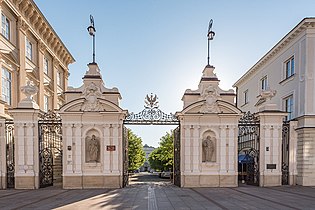Stefan Shiller
This article needs additional citations for verification. (February 2019) |
Stefan Szyller | |
|---|---|
 | |
| Born | September 4, 1857 |
| Died | June 22, 1933 (aged 75) |
| Education | Member Academy of Arts (1888)[1] |
| Alma mater | Imperial Academy of Arts (1881)[1] |
| Known for | Architecture |
| Awards | |
Stefan Szyller (4 September 1857—22 June 1933) was a Polish architect, eclectic representative, academician of the Imperial Academy of Arts.
Biography
[edit]Graduate of the Imperial Academy of Arts (1881). During his studies he received awards from the Academy of Arts: a small silver medal (1878), a large silver medal (1879), a small gold medal (1880) for the program “Project of the City Council”, a large gold medal (1881) for the program “Project of the district court in the capital. " Cool artist 1st degree. The title of academician (1888). The main works made in the Renaissance and Baroque style are in the Polish capital.[1]
Moved to Warsaw (1888). In Warsaw and its surroundings, Schiller created about 700 Renaissance and Baroque buildings and restored many historical buildings. Schiller was the chief editor of an architectural magazine and architect of the city of Warsaw.
Books
[edit]- Do we have Polish architecture? (1916)
- The tradition of folk architecture in Polish architecture (1917).
Works
[edit]-
The main building of the Warsaw Polytechnic Institute (1899–1901)
-
Library and gates of the University of Warsaw (1899–1901)
-
National Gallery of Art in Warsaw (1900)
-
Church of Saint Mary's Scapular in Druskininkai[2]
References
[edit]- ^ a b c d Directory of the Imperial Academy of Arts 1915, p. 412.
- ^ Kucharska, Jolanta (2004). Ilustrowany przewodnik po zabytkach na Wileńszczyźnie i Żmudzi: Wileńszczyzna, Żmudź, Kowno (in Polish). Burchard Edition. p. 48. ISBN 9788387654153.
Literature
[edit]- С. Н. Кондаков (1915). Юбилейный справочник Императорской Академии художеств. 1764-1914 (in Russian). Vol. 2. p. 412.




![Church of Saint Mary's Scapular in Druskininkai[2]](http://upload.wikimedia.org/wikipedia/commons/thumb/7/7a/Church_of_Saint_Marys_Scapular_in_Druskininkai.jpg/252px-Church_of_Saint_Marys_Scapular_in_Druskininkai.jpg)